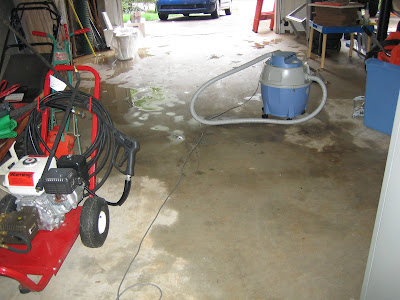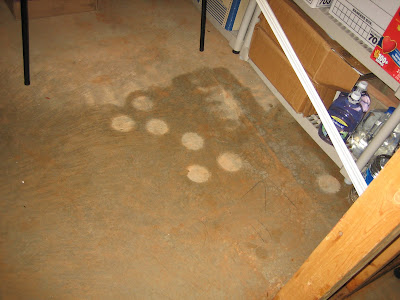 At 6:30 am on May 27, 2009, my husband went downstairs as usual to make our morning coffee. Unfortunately, we were not able to enjoy our coffee that morning.
At 6:30 am on May 27, 2009, my husband went downstairs as usual to make our morning coffee. Unfortunately, we were not able to enjoy our coffee that morning.
In the kitchen, he stepped into 1-1 ½ inches of water covering 2/3 of the kitchen area. It was coming from our Bosch dishwasher, and apparently had been flooding most of the night. Water was still coming out. This was not a leak of the 2-3 gallons of water used to run a load of dishes. This was a catastrophic failure. My husband turned off the water to the dishwasher, but it continued to drain out for several more hours. The water had gone under the vinyl flooring, as well as on top, causing the floor to undulate as we walked on it. The water had gone through the floor to the basement below and had flooded the basement as well. The water was raining down through the floor at many points, and had flooded ½ of the basement area. Many of our possessions in that area were soaked. The wood framing and floor joists in the affected area of the basement, from top to bottom, were soaked. The concrete basement floor had water standing on it, increasing as more water came from above.
To say that we were shocked, angered and devastated by what we encountered is an understatement, especially since we were simultaneously dealing with flooding on two floors of our house, caused by a dishwasher with a patented anti-flooding feature.
We had to work fast to stop the flooding and minimize its damage.
On the kitchen level, we started mopping, soaking up water with towels, cutting and removing the vinyl flooring to get to the plywood subfloor, hauling the vinyl flooring outside, wet-vac-ing the water up, opening windows, turning on fans, turning on dehumidifiers, turning on air conditioning, anything to remove the water.
We started moving the contents of the lower kitchen cabinets and the island cabinets to another room. We moved the refrigerator away from the wall to remove the flooring beneath it. In doing so, we noticed that the wall between the refrigerator and the adjacent dining room was also wet. While checking the dining room floor, we saw that the carpet, padding and subfloor in that room were wet as well.
In the basement, we did basically the same thing, mopping the water up, wet-vac-ing the water, and sweeping the water out into the garage and down the driveway. We put out buckets and plastic containers to catch as much dripping water from the ceiling as we could. We moved our possessions in that area out into the driveway, and started trying to dry them off. We set up dehumidifiers and heavy duty fans.
We used fans and dehumidifiers for three weeks before the wood was dry enough for the carpenters to begin their work.
We had to remove all particle board that had gotten wet, because once damp it cannot be salvaged. The toe boards/baseboard in the kitchen had a façade of oak over particle board, so we removed all affected toe boards at the base of the cabinets and the kitchen island, using a moisture meter to determine which wood was wet and which was dry.
By hand, we removed two layers of vinyl flooring down to the plywood subfloor, and began drying out the floor. In the dining room, we tried to dry out the padding, carpet and fiberboard, but gave up on them. In the basement, we used heavy-duty fans and dehumidifiers to dry the wood after sweeping, mopping and wet-vac-ing the water. We carried our wet and damaged personal possessions to dry areas as quickly as we could.
In the coming days and weeks, we contacted our insurance agency, we contacted the carpenter, we shopped for new flooring, we shopped for a new dishwasher. We moved the island and our dining room table and chairs to the den. We packed up the contents of the kitchen island cabinets and our dining room hunt-board, and moved them to other rooms. It was difficult to find things we needed because everything was scattered. We washed dishes by hand for eight weeks while the ongoing repairs were completed.
The repairs had to be orchestrated carefully, with every step done in the correct sequence. For example, the carpenter wanted the dishwasher out so he could accurately measure the cavity for the replacement wood. The flooring people wanted the toe boards/baseboard replaced, but not the molding/trim, before they started on the floor. The appliance people wanted the floor installed before the dishwasher went in. And on and on.
The disruption to our day-to-day lives was substantial, frustrating and time-consuming.
Labels for this post: bosch dishwasher, dishwasher, flood, leaking, water, kitchen, dining room, basement, bosch, flooring, vinyl flooring, particle board, rot, damage, subfloor, plywood, fiberboard, carpet
Labels: bosch, bosch dishwasher, clean-up, damage, defective, dehumidifiers, failure, fans, flooding, floors, vinyl flooring, wet vac





















































